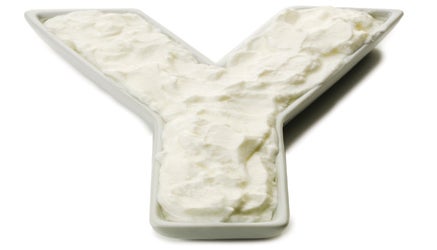Healing Foods: Yogurt

“A spoonful of yogurt helps the medicine go down” doesn’t exactly have the same
ring to it that “a spoonful of sugar” does in the original song. But even Mary Poppins
would have been impressed by the sheer numbers of “good” bacteria in the stuff .
Yogurt is made by adding two bacterial cultures, Lactobacillus bulgaricus and
Streptococcus thermophilus, to pasteurized milk to turn it into a thicker, fermented
form. All yogurts contain these cultures at the start, and many are supplemented with
additional probiotics that are associated with specifi c health benefits.
But how do probiotic bacteria in yogurt promote health? According to gastroenterologist
Daniel Neumann, MD, associate professor of medicine at Eastern Virginia
Medical School in Norfolk, Va., your intestines are populated with bacteria that must
maintain a delicate balance of power to keep things functioning properly.
“If one type of bacteria flourishes, the
whole intestinal democracy falls apart,”
he says. The imbalance can occur for a
variety of reasons. One of the most
common triggers is taking a course of
antibiotic medication (to treat, say, strep
throat), which attacks the good bacteria
in your intestines along with the bad.
A daily dose of yogurt can help offset
the resulting stomach issues. “Yogurt
replenishes bacteria that can help to
restore balance in the intestinal system,”
explains Neumann, who also recommends
patients try yogurt for digestive
problems such as irritable bowel
syndrome, gas, and bloating.
Though some experts question
whether yogurt contains suffi cient live
cultures to relieve specific ailments, early
studies indicate that probiotic cultures in
yogurt are intricately intertwined with
our health, says Gary Huffnagle, PhD,
author of The Probiotics Revolution. “We’re
finding that the bacteria living in the
body provide important signals,
messages, and nutrients to the immune
system,” he adds. “For general health
and low-grade problems, I am a huge
proponent of yogurt.”
There is also a growing body of clinical evidence to support the use of yogurt
supplemented with specifi c strains of
probiotics. In a Taiwanese study
published in the American Journal of
Clinical Nutrition in 2004, volunteers
who ate yogurt fortifi ed with L. acidophilus
and B. lactis twice daily had a reduced
risk of infection by the bacteria responsible
for most digestive ulcers.
A 2003 Finnish study, also published
in the American Journal of Clinical
Nutrition, showed a correlation for
women who frequently consumed probiotic-fermented milk products plus fresh
berry juice and a lower recurrence of
urinary tract infections.
Take away the probiotic factor, and
yogurt still boasts impressive health
benefits. One serving is loaded with
calcium, protein, and vitamins. “Yogurt
is a great source of calcium,” says Felicia
Cosman, MD, clinical director of the
National Osteoporosis Foundation.
“The target number for calcium is
1,200 milligrams per day, and an average
8-ounce serving of yogurt provides
300 milligrams,” she adds.
While yogurt can be used in a variety
of savory dips and sauces, a little sugar
does help this medicine go down. But
avoid presweetened and flavored yogurts
that can be overly sweet and high in
calories. Instead, choose low-fat or skim
plain yogurt and add a teaspoon or two
of 100 percent fruit spread, a little maple
syrup or honey, some fresh or dried
fruitthese are all prescriptions that are
easy to swallow.
Supplement Savvy
For a concentrated dose of probiotics, supplement options are available in a
variety of forms, including liquid, capsules, and tablets.
What to look for Choose a product that contains genus, species, and
strain information and prints an expiration date for its living organisms.
How to take it Recommended dosage for probiotic supplements is 1 billion
to 10 billion CFUs (colony forming units) per strain daily. It’s often recommended
to take probiotics 2 hours after prescribed antibiotics to reduce the
chance of the antibiotics killing the probiotic organisms.
Safety Though not tested or regulated by the FDA, probiotic supplements are
on the FDA’s “generally recognized as safe” list, but avoid anything with
“bacillus” or “enterococci” on the label.